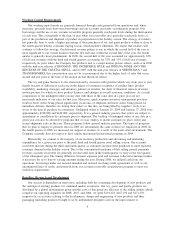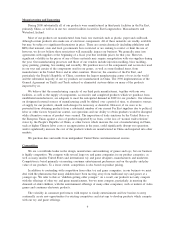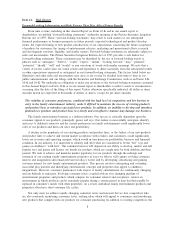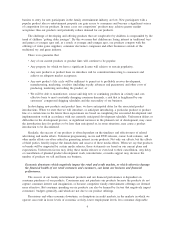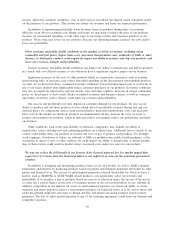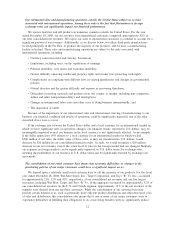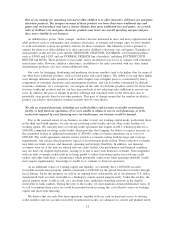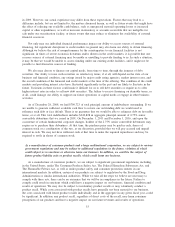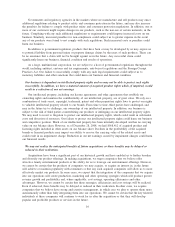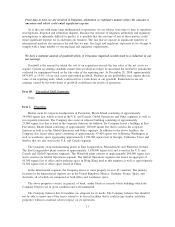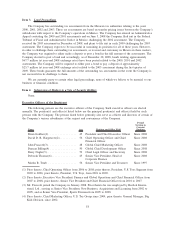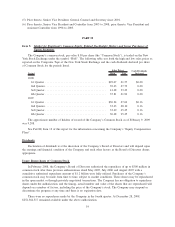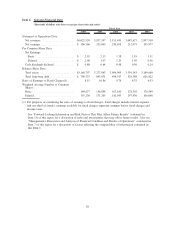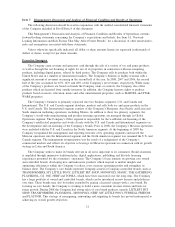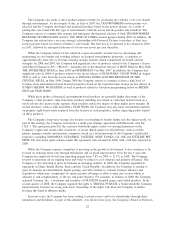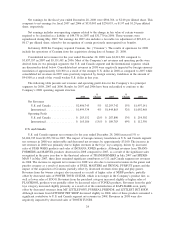Hasbro 2008 Annual Report Download - page 24
Download and view the complete annual report
Please find page 24 of the 2008 Hasbro annual report below. You can navigate through the pages in the report by either clicking on the pages listed below, or by using the keyword search tool below to find specific information within the annual report.Part of our strategy for remaining relevant to older children is to offer innovative children’s toy and game
electronic products. The margins on many of these products are lower than more traditional toys and
games and such products may have a shorter lifespan than more traditional toys and games. As a result,
sales of children’s toy and game electronic products may lower our overall operating margins and pro-
duce more volatility in our business.
As children have grown “older younger” and have become interested in more and more sophisticated and
adult products, such as videogames and consumer electronics, at younger and younger ages, we have needed
to work even harder to keep our products relevant for these consumers. One initiative we have pursued to
capture the interest of older children is to offer innovative children’s electronic toys and games. Examples of
such products in the last few years include VIDEONOW, CHATNOW, ZOOMBOX, our I-branded products
such as I-DOG and I-CAT, and our FURREAL FRIENDS line of products, including BUTTERSCOTCH,
BISCUIT and KOTA. These products, if successful, can be an effective way for us to connect with consumers
and increase sales. However, children’s electronics, in addition to the risks associated with our other family
entertainment products, also face certain additional risks.
Our costs for designing, developing and producing electronic products tend to be higher than for many of
our other more traditional products, such as board games and action figures. The ability to recoup these higher
costs through sufficient sales quantities and to reflect higher costs in higher prices is constrained by heavy
competition in consumer electronics and entertainment products, and can be further constrained by difficult
economic conditions. As a consequence, our margins on the sales of electronic products tend to be lower than
for more traditional products and we can face increased risk of not achieving sales sufficient to recover our
costs. In addition, the pace of change in product offerings and consumer tastes in the electronics area is
potentially even greater than for our other products. This pace of change means that the window in which a
product can achieve and maintain consumer interest may be even shorter.
We rely on external financing, including our credit facilities and accounts receivable securitization
facility, to help fund our operations. If we were unable to obtain or service such financing, or if the
restrictions imposed by such financing were too burdensome, our business would be harmed.
Due to the seasonal nature of our business, in order to meet our working capital needs, particularly those
in the third and fourth quarters, we rely on our revolving credit facility and our other credit facilities for
working capital. We currently have a revolving credit agreement that expires in 2011, which provides for a
$300,000 committed revolving credit facility which provides the Company the ability to request increases in
the committed facility in additional increments of $50,000, subject to lender agreement, up to a total of
$500,000. The credit agreement contains certain restrictive covenants setting forth leverage and coverage
requirements, and certain other limitations typical of an investment grade facility. These restrictive covenants
may limit our future actions, and financial, operating and strategic flexibility. In addition, our financial
covenants were set at the time we entered into our credit facility. Our performance and financial condition
may not meet our original expectations, causing us to fail to meet such financial covenants. Non-compliance
with our debt covenants could result in us being unable to utilize borrowings under our revolving credit
facility and other bank lines, a circumstance which potentially could occur when operating shortfalls would
most require supplementary borrowings to enable us to continue to fund our operations.
As an additional source of working capital and liquidity, we currently have a $250,000 accounts
receivable securitization program, which is increased to $300,000 for the period from fiscal October through
fiscal January. Under this program, we sell on an ongoing basis, substantially all of our domestic U.S. dollar
denominated trade accounts receivable to a bankruptcy remote special purpose entity. Under this facility, the
special purpose entity is able to sell, on a revolving basis, undivided ownership interests in the eligible
receivables to bank conduits. During the term of the facility, we must maintain certain performance ratios. If
we fail to maintain these ratios, we could be prevented from accessing this cost-effective source of working
capital and short-term financing.
We believe that our cash flow from operations, together with our cash on hand and access to existing
credit facilities and our accounts receivable securitization facility, are adequate for current and planned needs
14


